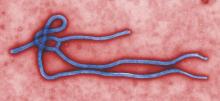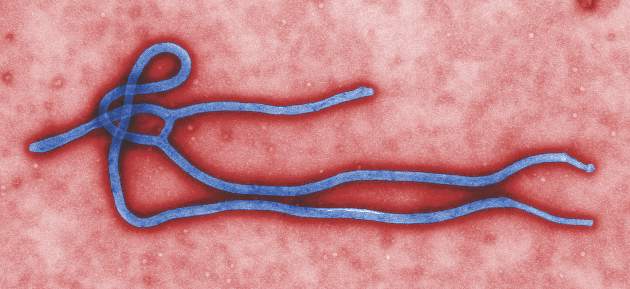User login
Biomarkers associated with severe Ebola virus disease (EVD) were more specific than were those associated with moderate EVD, in a small study, according to Dr. Anita K. McElroy and her associates.
In the study of seven (two severe, five moderate) patients with EVD, 54 biomarkers in plasma samples were analyzed to define the kinetics of inflammatory modulators. Of these, 6 had a statistically significant association with moderate disease and 17 with severe disease. The patients with severe disease had higher viremia (P = .0003). Among 16 biomarkers correlated with viremia, 11 were associated with severe disease.
The researchers noted that the interleukin-6 differences between moderate and severe disease were not statistically significant because of the small numbers of samples in the moderate group that had detectable levels; however, there is a direct association between severity and interleukin-6 levels.
“The results from this study illuminate the beneficial vs. harmful host immune responses in EVD,” the researchers concluded. “The next step is to generate testable hypotheses about these physiologic processes and evaluate them using relevant animal models.”
Find the full study in Clinical Infectious Diseases (doi: 10.1093/cid/ciw334).
Biomarkers associated with severe Ebola virus disease (EVD) were more specific than were those associated with moderate EVD, in a small study, according to Dr. Anita K. McElroy and her associates.
In the study of seven (two severe, five moderate) patients with EVD, 54 biomarkers in plasma samples were analyzed to define the kinetics of inflammatory modulators. Of these, 6 had a statistically significant association with moderate disease and 17 with severe disease. The patients with severe disease had higher viremia (P = .0003). Among 16 biomarkers correlated with viremia, 11 were associated with severe disease.
The researchers noted that the interleukin-6 differences between moderate and severe disease were not statistically significant because of the small numbers of samples in the moderate group that had detectable levels; however, there is a direct association between severity and interleukin-6 levels.
“The results from this study illuminate the beneficial vs. harmful host immune responses in EVD,” the researchers concluded. “The next step is to generate testable hypotheses about these physiologic processes and evaluate them using relevant animal models.”
Find the full study in Clinical Infectious Diseases (doi: 10.1093/cid/ciw334).
Biomarkers associated with severe Ebola virus disease (EVD) were more specific than were those associated with moderate EVD, in a small study, according to Dr. Anita K. McElroy and her associates.
In the study of seven (two severe, five moderate) patients with EVD, 54 biomarkers in plasma samples were analyzed to define the kinetics of inflammatory modulators. Of these, 6 had a statistically significant association with moderate disease and 17 with severe disease. The patients with severe disease had higher viremia (P = .0003). Among 16 biomarkers correlated with viremia, 11 were associated with severe disease.
The researchers noted that the interleukin-6 differences between moderate and severe disease were not statistically significant because of the small numbers of samples in the moderate group that had detectable levels; however, there is a direct association between severity and interleukin-6 levels.
“The results from this study illuminate the beneficial vs. harmful host immune responses in EVD,” the researchers concluded. “The next step is to generate testable hypotheses about these physiologic processes and evaluate them using relevant animal models.”
Find the full study in Clinical Infectious Diseases (doi: 10.1093/cid/ciw334).
FROM CLINICAL INFECTIOUS DISEASES

